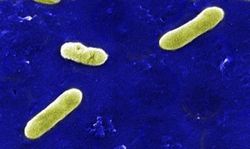Bordetella species - Overview
| Bordetella | |
|---|---|
| Phylum | Proteobacteria |
| Class | Beta Proteobacteria |
| Order | Burkholderiales |
| Family | Alcaligenaceae |
| Genus | Bordetella |
Overview
The Bordetella species are normal inhabitants of the upper respiratory tract and can cause respiratory diseases including Atrophic Rhinitis, tracheitis and bronchitis and bronchiolitis. The species B. bronchiseptica infects a wide range of animal species worldwide, whereas B. avium is resticted to birds. Bordetella species cause exogenous or endogenous infection which is of high morbidity and low mortality. They have poor survival in the environment. Transmission occurs between animals and young animals are particularly susceptible. Predisposing factors to Bordetella include stress and concurrent infections. The organisms are named in Honor of the scientist 'Bordet'.
Characteristics
The Bordetella species are Gram negative rods. They are strict aerobes that are catalase and oxidase positive. They grow slowly and are non-lactose fermentors that grow on MacConkey agar. Toxigenic strains agglutinate mammalian red blood cells. There is identical S form of LPS in all strains of B. bronchiseptica. B. bronchiseptica are haemolytic, whereas B. avium are not. They both have an affinity for ciliated respiratory epithelium.
Pathogenesis and pathogenicity
The Bordetella species use pathogenicity factors such as filamentous haemagglutanin (only B. bronchiseptica), fimbriae and pertactin to adhere to ciliated respiratory epithelium. They produce toxins including;
- Adenylate cyclase, a leucocyte toxin that kills phagocytes. (only Bordetella bronchiseptica)
- Tracheal cytotoxin which inhibits DNA synthesis in ciliated cells.
- Dermonecrotic toxin.
Pathogenicity factors are activated by the environment and genetic changes. Phase variation: genetic switch of Bvg locus allows transciption of pathogenicity factors. Phenotypic modulation: temperature, magnesium ions and nicotinic acid affect the expression of the pathogenicity factors. Bvg positive allows the expression of pathogenicity factors and toxins and colonisation, whereas Bvg negative may allow survival in the environment with the production of flagellae. Mucosal IgA prevents the attachment of bacteria to cilia, but clearance from the respiratory tract may take weeks. Carrier animals are a source of infection.
Diagnosis
To diagnose Bordetella, samples can be taken including nasal swabs, tracheal aspirates and exudates. They can be cultured on blood agar and MacConkey agar. Biochemical profiles can be done and slide agglutination tests for virulence of isolates.
See here for a list of Bordetella species
| This article has been peer reviewed but is awaiting expert review. If you would like to help with this, please see more information about expert reviewing. |
Error in widget FBRecommend: unable to write file /var/www/wikivet.net/extensions/Widgets/compiled_templates/wrt693940a38656e8_68168005 Error in widget google+: unable to write file /var/www/wikivet.net/extensions/Widgets/compiled_templates/wrt693940a3921589_78238588 Error in widget TwitterTweet: unable to write file /var/www/wikivet.net/extensions/Widgets/compiled_templates/wrt693940a39afca9_55254012
|
| WikiVet® Introduction - Help WikiVet - Report a Problem |
